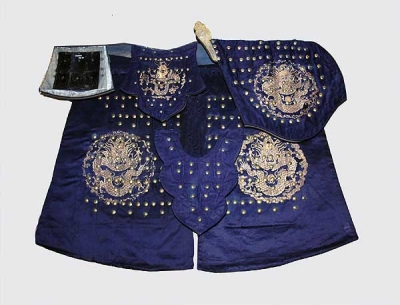Brigandine armour (1884.31.27)
 ChinaBrigandine armour from China, Asia. Part of the Pitt Rivers Museum Founding Collection. Given to the Museum in 1884.
ChinaBrigandine armour from China, Asia. Part of the Pitt Rivers Museum Founding Collection. Given to the Museum in 1884.
This may look like a rather ornate cape but it is in fact a piece of extremely heavy, yet protective and flexible, armour. It is a type of scale armour known as 'brigandine', composed of oblong iron plates. These are covered with dark blue, gold-embroidered satin and the whole is lined with canvas, to which plates are fixed, through the satin, with brass studs or rivets.
The style was first used in the 8th century and was popular in China where it was known as ting kia ('armour with nails'). Shown here is an aristocratic piece from the late 18th or the early 19th century, consisting of an apron, left shoulder-guard, underarm gusset, groin-flap and a piece from the back of a helmet. The complete armour would have also included a jacket and high boots.
Warrior Elites
This suit of armour dates from the second half of the Ch'ing or Manchu dynasty (1644-1911), the final dynasty of the Empire. Its rich blue silk brocade and the embroidered scheme of dragons wreathed in cloud-scrolls are typical features of courtly Manchu finery.
The Ch'ing emperors were of Mongolian origin, and found the courtly art style of the preceding Ming dynasty too centralised, urban and restrained. They used bright primary colours and harmonious colour-balances. They also developed an intentionally archaic style of court art, which resembled the styles of the Warring States (481-206 BC) and Han (206 BC-221 AD) periods. This can be seen in Ch'ing architecture, painting, furniture-making and textiles, and involved the use of ancient Taoist motifs like the dragon, cloud-scrolls, the lingzhi fungus (a symbol of fertility and immortality), and so on. This style was an artistic device that gave the new, foreign dynasty an appearance of legitimate Chinese ethnic identity. The dragon is an important symbol in the Taoist religion, and signifies yang, the male half of the universe and the forceful, light, growing, active and determining principle. The dragon also symbolises water, clouds and rain as the powers of fertility and growth. The paired dragons were one of the twelve imperial symbols of the Ch'ing emperor, as well as being particularly suited to a suit of princely armour.
The iconography of Ch'ing courtly uniforms such as this was rigidly graded and the emperor alone was entitled to wear the image of the five-clawed dragon face-on. Princes of the first rank wore face-on five-clawed dragons on their chests, but those on the shoulders had to be in profile. Princes of the second rank wore all of their five-clawed dragons in profile, while princes of the third rank wore four-clawed dragons face-on, as appear on this example. It seems, therefore, that this suit of armour was made for a low-ranked prince. Some similar court uniforms exist in other museum collections, 'false brigandines' with rivets but without plates inside, which are considered to be the court uniforms of more minor military officials.
It is a common myth that brigandines were so-named by the English because they were a popular choice of protection for bandits and outlaws. In fact, the term 'brigand' referred to a foot soldier so brigandine was simply a type of armour worn by infantry. Its removal from this lowly association is proved by its fashionable status and ostentatious display among aristocrats, not just in Asia but in Europe too. It was the animated and free-flowing designs of Chi'ing icongraphy such as this dragon motif, which also gave rise to fanciful interpretations of Chinese forms in European decorative arts of hte 17th and 18th centuries, known as 'chinoiserie'.





